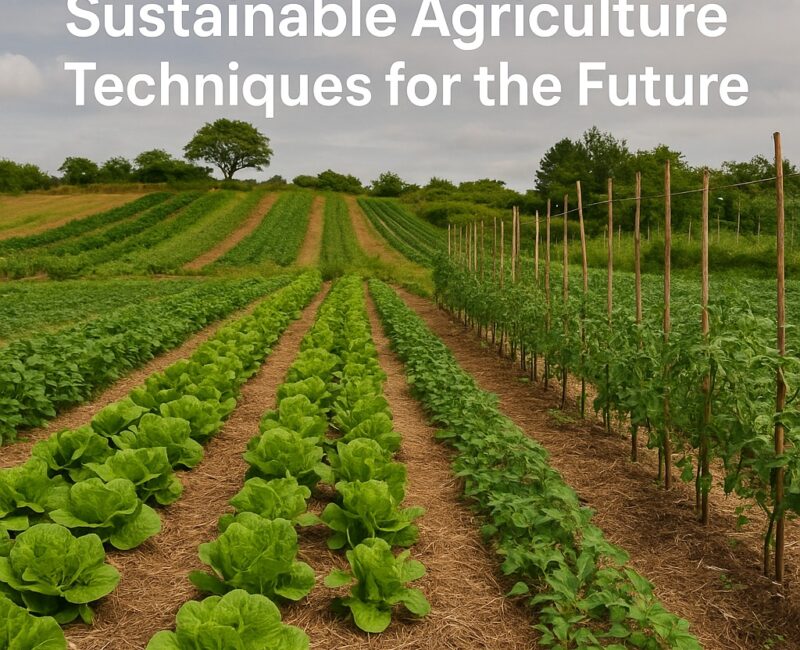Sustainable agriculture is no longer just a buzzword—it’s the only way forward. As the climate changes and natural resources grow scarce, adopting smart, future-ready farming methods becomes a survival strategy. Whether you’re a small farmer or a large agribusiness, the shift to sustainable techniques can mean lower costs, healthier soil, higher yields, and a cleaner planet.
In this article, we’ll explore the top sustainable agriculture techniques that are transforming farms across the globe—especially in North America, Europe, Australia, and New Zealand.
Why Sustainable Farming is the Future
🌍 Global populations are rising while farmland is shrinking. 💧 Water shortages and climate disruptions demand smarter irrigation and soil use. 📈 Consumer demand is shifting to eco-conscious, pesticide-free produce.
Sustainable agriculture balances the triple bottom line—people, planet, and profits.
Top 10 Sustainable Agriculture Techniques for the Future
1. Regenerative Agriculture
Regenerative ag goes beyond sustainability by actually improving the land.
- Focuses on building soil organic matter
- Uses crop rotation, cover crops, and compost
- Sequesters carbon naturally
📍 Popular in: USA (California), UK, Australia
2. Precision Agriculture
Using AI, IoT, and GPS tools to apply water, fertilizer, and pesticides only where needed.
- Reduces waste and input costs
- Increases yield per acre
- Enables data-driven decision making
📍 Used heavily in: Germany, Netherlands, USA
3. Agroforestry
Combines trees, shrubs, and crops in a single farming system.
- Improves biodiversity
- Prevents erosion and runoff
- Adds revenue from timber/fruits
📍 Adopted in: Canada, France, New Zealand
4. Vertical and Indoor Farming
Perfect for urban and peri-urban areas where space is tight.
- Uses hydroponics or aeroponics
- Reduces water usage by 90%
- Year-round growing possible
📍 On the rise in: US cities, UK, Germany, Singapore
5. Organic and No-Till Farming
Organic farming avoids synthetic inputs, while no-till reduces soil disturbance.
- Builds healthier topsoil
- Reduces fossil fuel use
- Encourages beneficial microbes
📍 Certified in: USA, UK, Denmark, Canada
6. Crop Rotation and Polyculture
Avoid monocropping by mixing crops or rotating them each season.
- Reduces disease and pests
- Balances nutrient cycles
- Improves soil fertility
📍 Traditional practice modernized in: Australia, USA, Europe
7. Biological Pest Control
Uses beneficial insects, fungi, or bacteria to keep pests in check.
- Eliminates need for toxic pesticides
- Maintains natural predator balance
📍 Popular with: Organic farms globally
8. Solar-Powered Irrigation Systems
Farms can use solar energy for pumps, irrigation, and even storage.
- Saves energy costs
- Reduces emissions
📍 High adoption in: India, Australia, Southern US
9. Smart Water Management
Drip irrigation, moisture sensors, and water harvesting methods.
- Increases water efficiency
- Prevents overwatering
📍 Critical in: Drought-prone areas of USA, Spain, Africa
10. Community-Supported Agriculture (CSA) Models
Consumers subscribe to receive regular produce, giving farmers upfront capital.
- Encourages seasonal growing
- Builds farmer-consumer trust
- Supports local economy
📍 Exploding in: US, UK, Canada
Future Trends to Watch in Sustainable Agriculture
🔬 Bioengineering for Resilient Crops 🤖 Robotics & Drones in Soil and Crop Health Monitoring 🌐 Blockchain for Transparent Supply Chains 🌿 Carbon Farming Incentives from governments and NGOs
Benefits of Adopting These Techniques
✅ Higher yields with fewer inputs
✅ Better resilience to climate shocks
✅ Enhanced brand value for eco-conscious consumers
✅ Access to grants and subsidies from governments (see Week 8 article)
Country-wise Adoption Snapshot
| Country | Key Technique Adoption |
|---|---|
| USA | Precision ag, CSA, Regenerative |
| UK | No-till, Organic, Urban vertical |
| Germany | AI irrigation, Polyculture |
| Canada | Agroforestry, Smart irrigation |
| Australia | Solar-powered irrigation, Rotation |
| New Zealand | Organic, CSA, Regenerative |
How to Get Started
- Start small: Begin with 1 or 2 techniques and scale up.
- Take local climate and soil into account.
- Join online or local sustainable farming communities.
- Apply for available green agri-grants.
Conclusion
Sustainable agriculture isn’t just a good idea—it’s the way forward for every modern farmer. As climate challenges rise and consumer demand evolves, adopting future-friendly practices can help you grow smarter, greener, and more profitably.
Stay ahead of the curve—because farming smarter is the new farming harder.





